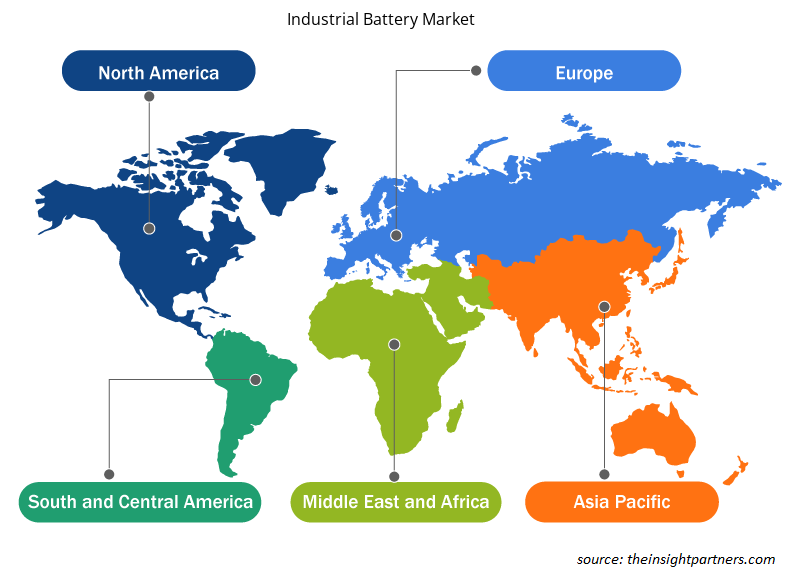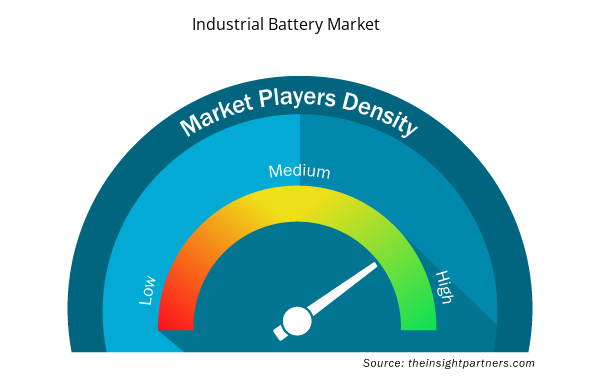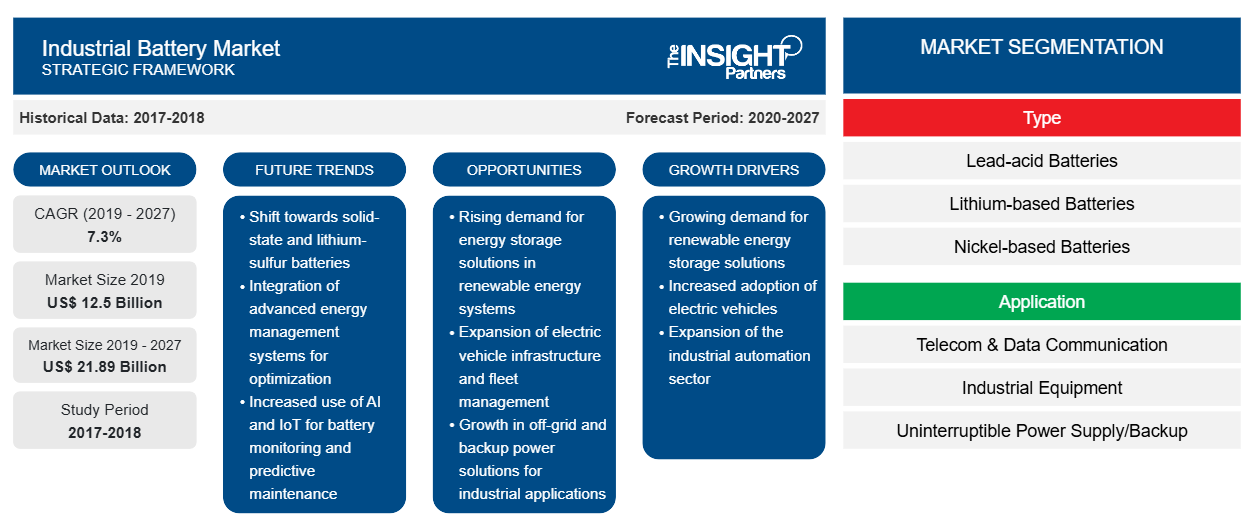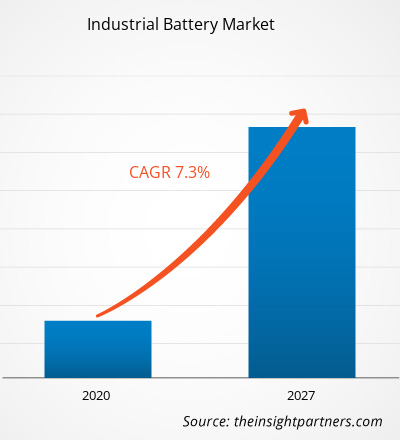Der Markt für Industriebatterien wurde im Jahr 2019 auf 12.501,9 Millionen US-Dollar geschätzt und soll von 2020 bis 2027 mit einer durchschnittlichen jährlichen Wachstumsrate von 7,3 % wachsen und bis 2027 21.893,5 Millionen US-Dollar erreichen.
Industriebatterien sind speziell entwickelte Batterien, die unter rauen industriellen Temperaturen wie extremen Temperaturen, stärkeren Vibrationen und starker Beanspruchung betrieben werden können. Industriebatterien sind leistungsfähiger und leistungsstärker. Im gegenwärtigen Marktszenario arbeiten die Unternehmen konsequent an der Entwicklung hocheffizienter Batterien, die den unterschiedlichen Anforderungen an Industriebatterien gerecht werden. Der globale Markt für Industriebatterien wird im Prognosezeitraum voraussichtlich ein beeindruckendes Wachstum verzeichnen. Die Nachfrage nach Lithium-basierten Batterien wird im Prognosezeitraum voraussichtlich deutlich steigen. Die Einführung von Lithium-Batterien wird voraussichtlich in verschiedenen Branchen zunehmen, da sie Vorteile wie geringe Emissionen, längere Lebensdauer und Recyclingfähigkeit bieten. Die auf dem Markt tätigen Unternehmen konzentrieren sich auf die Entwicklung neuer Produkte, um eine starke Kundenbasis aufzubauen und einen signifikanten Marktanteil zu erreichen.
Die Regierungen nordamerikanischer Länder wie der USA unternehmen kontinuierlich Schritte, um die Produktivität der Fertigungsindustrie zu steigern. Sie stellen beispielsweise die neuesten Technologien bereit, um den Herstellungsprozess zu vereinfachen, und erhöhen die Anzahl der Lagerhäuser. Der Einsatz automatisierter Technologien in diesen Lagerhäusern wird voraussichtlich das Wachstum des Marktes für Industriebatterien in Nordamerika beeinflussen. Die erhöhten Ausgaben der Regierung führen zur Entwicklung jeglicher Technologie. In der nordamerikanischen Region sind die staatlichen Ausgaben für technologische Fortschrittsaktivitäten recht hoch, was das Klima für das Gedeihen jedes Unternehmens günstig macht. IoT, Big Data und fortschrittliche Technologien haben in dieser Region eine hohe Akzeptanz erfahren. Diese Technologien wiederum treiben die Anforderungen des verbesserten Netzwerks sowie die Nachfrage nach Industriebatterien voran. Einige der aufkommenden Technologien auf dem Markt für Industriebatterien sind Lithium-Ionen-Batterien (Li-Ionen) der neuen Generation, Lithium-Schwefel-Batterien, Festkörperbatterien, Aluminium-Ionen-Batterien usw.
Passen Sie diesen Bericht Ihren Anforderungen an
Sie erhalten kostenlose Anpassungen an jedem Bericht, einschließlich Teilen dieses Berichts oder einer Analyse auf Länderebene, eines Excel-Datenpakets sowie tolle Angebote und Rabatte für Start-ups und Universitäten.
- Holen Sie sich die wichtigsten Markttrends aus diesem Bericht.Dieses KOSTENLOSE Beispiel umfasst eine Datenanalyse von Markttrends bis hin zu Schätzungen und Prognosen.
Markteinblicke
Netzgekoppelte Lösungen für unterbrechungsfreie Stromversorgung treiben die Nachfrage nach Industriebatterien
Die bekanntesten und wichtigsten Arten erneuerbarer Energiequellen sind Solar- und Windenergie, die im Netz gespeichert werden. Wenn die Sonne jedoch von Wolken verdeckt wird oder die Windströmung schwankt, kann dies zu Abweichungen im Prozess der Energieerzeugung führen. Solche Veränderungen erfordern flexible Netzsysteme zur Energiespeicherung. Industrielle Batteriespeichersysteme helfen den Netzbetreibern, Strom zu sparen, wenn die Strommenge den Strombedarf übersteigt. Die zunehmende Einführung dieser Systeme trägt somit dazu bei, die Zuverlässigkeit und Flexibilität des Stromversorgungssystems in Bezug auf Erzeugung, Übertragung und Verteilung zu verbessern. Während der Übertragung und Verteilung übernehmen Batteriespeichersysteme verschiedene Aspekte wie Anlagenverschiebung, Oberwellenunterdrückung, Spannungsunterstützung, Frequenzregelung und Stromqualität. Zeitverschiebung von elektrischer Energie, Zeitverschiebung von erneuerbarer Energie, Grundlastausgleich und Spitzenlastkappung sowie Festigung der Kapazität erneuerbarer Energien sind weitere Vorteile der Verwendung von Batteriespeichersystemen für netzgekoppelte Lösungen, die die Einführung dieser Systeme vorantreiben und so das Wachstum des Marktes für Industriebatterien befeuern. Die Marktteilnehmer entwickeln neue Netzlösungen, um auf dem Markt für Industriebatterien wettbewerbsfähig zu bleiben. Siemens bietet beispielsweise SIESTORAGE an, eine intelligente Netzlösung. SIESTORAGE ist in der Lage, die Herausforderungen zu bewältigen, die während der drei Hauptaspekte der Stromversorgung auftreten, d. h. Netzverbindungen optimieren, elastische Energie für moderne Netze bereitstellen und große Energieverbraucher unterstützen. Darüber hinaus hat EDP Distribuicao im Juli 2015 eine Ausschreibung für Storage InovGrid für SIESTORAGE von Siemens in Évora (Portugal) angeboten. Das SIESTORAGE-System bietet Dienste wie Spannungsregulierung, Energie-Backup und Spitzenlastausgleich für die Netzstabilität von EDP und repliziert die Vorteile intelligenter Netze für die Netzbetreiber.
Typ-Einblicke
Im Typensegment haben Bleibatterien den größten Anteil am globalen Markt für Industriebatterien. Bleibatterien sind kostengünstig und leistungsstark, können leicht recycelt und einfach aufgeladen werden. Aufgrund ihrer geringen Kosten und langen Lebensdauer werden Bleibatterien häufig eingesetzt. Allerdings sind sie für eine dauerhaft hohe Belastung nicht geeignet. Zudem haben sie eine relativ geringe volumetrische Energiedichte, was ihren Einsatz für Energiemanagementanwendungen etwas ungeeignet macht. Daher werden sie hauptsächlich für Stromanwendungen verwendet. Die Weiterentwicklung dieser Batterie ist noch nicht abgeschlossen, was sie zu einer praktikableren Option für das Energiemanagement machen könnte.
Anwendungseinblicke
Der Markt für Industriebatterien ist nach Anwendung in Telekommunikation und Datenkommunikation, Industrieausrüstung, unterbrechungsfreie Stromversorgung (USV)/Backup, Bergbau, Schifffahrt und andere unterteilt. Das Segment Industrieausrüstung hat den dominierenden Anteil am globalen Markt für Industriebatterien erobert. Die wachsenden Industrie 4.0-Trends wie IoT, künstliche Intelligenz (KI), Big-Data-Analyse, vernetzte Kommunikation, Cloud-Computing und maschinelle Lerntechnologien markieren einen wesentlichen Wandel in der Arbeitsweise von Unternehmen und in der Art und Weise, wie sie mit ihren Kunden interagieren. Solche wachsenden Technologien bieten innovative Industrieausrüstungslösungen, die die Produktion und Lieferung effizienter Ausrüstung unterstützen.
Fusions- und Übernahmestrategien werden häufig von Unternehmen verfolgt, um ihre Präsenz weltweit zu erweitern und die wachsende Nachfrage zu decken. Diese Strategie wird vor allem in Nordamerika und Europa verfolgt. Die Akteure auf dem Markt für Industriebatterien verfolgen die Strategie der Expansion und Investition in Forschung und Entwicklung, um den Kundenstamm weltweit zu vergrößern, was es den Akteuren auch ermöglicht, ihren Markennamen weltweit aufrechtzuerhalten. Einige der jüngsten Übernahmen sind unten aufgeführt:
2019: East Penn gab den Erwerb der Mehrheitsbeteiligung an Navitas Systems bekannt. Diese Übernahme soll die Erweiterung des Angebots an Motive Power Battery unterstützen.
2019: Saft gab den Erwerb von 100 % der Anteile an Go Electric Inc. bekannt, einem in den USA ansässigen Entwickler von Lösungen zur verteilten Energieausfallsicherheit für Mikronetze sowie gewerbliche und industrielle Kunden.
Regionale Einblicke in den Markt für Industriebatterien
Die regionalen Trends und Faktoren, die den Markt für Industriebatterien im Prognosezeitraum beeinflussen, wurden von den Analysten von Insight Partners ausführlich erläutert. In diesem Abschnitt werden auch die Marktsegmente und die Geografie des Marktes für Industriebatterien in Nordamerika, Europa, im asiatisch-pazifischen Raum, im Nahen Osten und Afrika sowie in Süd- und Mittelamerika erörtert.

- Erhalten Sie regionale Daten zum Markt für Industriebatterien
Umfang des Marktberichts für Industriebatterien
| Berichtsattribut | Details |
|---|---|
| Marktgröße im Jahr 2019 | 12,5 Milliarden US-Dollar |
| Marktgröße bis 2027 | 21,89 Milliarden US-Dollar |
| Globale CAGR (2019 - 2027) | 7,3 % |
| Historische Daten | 2017-2018 |
| Prognosezeitraum | 2020–2027 |
| Abgedeckte Segmente | Nach Typ
|
| Abgedeckte Regionen und Länder | Nordamerika
|
| Marktführer und wichtige Unternehmensprofile |
|
Dichte der Marktteilnehmer für Industriebatterien: Auswirkungen auf die Geschäftsdynamik verstehen
Der Markt für Industriebatterien wächst rasant, angetrieben durch die steigende Nachfrage der Endnutzer aufgrund von Faktoren wie sich entwickelnden Verbraucherpräferenzen, technologischen Fortschritten und einem größeren Bewusstsein für die Vorteile des Produkts. Mit steigender Nachfrage erweitern Unternehmen ihr Angebot, entwickeln Innovationen, um die Bedürfnisse der Verbraucher zu erfüllen, und nutzen neue Trends, was das Marktwachstum weiter ankurbelt.
Die Marktteilnehmerdichte bezieht sich auf die Verteilung der Firmen oder Unternehmen, die in einem bestimmten Markt oder einer bestimmten Branche tätig sind. Sie gibt an, wie viele Wettbewerber (Marktteilnehmer) in einem bestimmten Marktraum im Verhältnis zu seiner Größe oder seinem gesamten Marktwert präsent sind.
Die wichtigsten auf dem Markt für Industriebatterien tätigen Unternehmen sind:
- C&D Technologies, Inc.
- East Penn Fertigungsunternehmen
- EnerSys
- Exide Industries Limited
- Allgemeine Elektrizit?tsgesellschaft
Haftungsausschluss : Die oben aufgeführten Unternehmen sind nicht in einer bestimmten Reihenfolge aufgeführt.

- Überblick über die wichtigsten Akteure auf dem Markt für Industriebatterien
Markt für Industriebatterien – nach Typ
- Blei-Säure-Batterien
- Lithium-basierte Batterien
- Nickelbasierte Batterien
- Sonstiges
Markt für Industriebatterien – nach Anwendung
- Telekommunikation und Datenkommunikation
- Industrielle Ausrüstung
- USV/Backup
- Energiespeicherung auf Netzebene
- Bergbau
- Marine
- Sonstiges
Globaler Markt für Industriebatterien nach Regionen
Nordamerika
- UNS
- Kanada
- Mexiko
Europa
- Frankreich
- Deutschland
- Italien
- Vereinigtes Königreich
- Russland
- Restliches Europa
Asien-Pazifik
- China
- Indien
- Südkorea
- Japan
- Australien
- Restlicher Asien-Pazifik-Raum
Naher Osten und Afrika
- Südafrika
- Saudi-Arabien
- Vereinigte Arabische Emirate
- Restlicher Naher Osten und Afrika
Südamerika
- Brasilien
- Argentinien
- Restliches Südamerika
Firmenprofile
- C&D Technologies, Inc.
- East Penn Fertigungsunternehmen
- EnerSys
- Exide Industries Limited
- Allgemeine Elektrizit?tsgesellschaft
- GS Yuasa International Ltd.
- LG Chem
- Panasonic Corporation
- Robert Bosch GmbH
- Saft Groupe SA
- Historische Analyse (2 Jahre), Basisjahr, Prognose (7 Jahre) mit CAGR
- PEST- und SWOT-Analyse
- Marktgröße Wert/Volumen – Global, Regional, Land
- Branche und Wettbewerbsumfeld
- Excel-Datensatz



Report Coverage
Revenue forecast, Company Analysis, Industry landscape, Growth factors, and Trends

Segment Covered
This text is related
to segments covered.

Regional Scope
North America, Europe, Asia Pacific, Middle East & Africa, South & Central America

Country Scope
This text is related
to country scope.
Häufig gestellte Fragen
The Industrial Equipment sector is the leading industry in the market, which comprises machinery, large scale process, and construction industry plants. The growing industry 4.0 trends, such as IoT, Artificial Intelligence (AI), big data analysis, networked communications, cloud computing, and machine learning technologies, are marking a substantial change in the businesses model and the way of attracting customers. Such growing technologies are offering innovative industrial equipment solutions that support the production and delivery of efficient equipment. In order to operate a warehouse or heavy machinery, the need for material handling equipment batteries is necessary. Lithium-ion batteries are ideally used for the equipment used in various industries, such as food and beverage and tissue industries. Increasing use of industrial equipment in areas such as airport ground support, lift trucks, sweepers, and scrubbers, and automatic guided vehicles (AGV) is propelling the growth of industrial battery market.
The APAC region led the Industrial Battery market in 2019 as the factors such as the growing industrial equipment, mining, and marine industries, stringent environmental regulations, and reduced labor costs associated with battery recycling are the factors boosting the APAC industrial battery market growth.
Governments across the world are focusing on expanding the reach of digitization and promoting the utilization of several electronic devices, and have become the most important storage technology in the areas of portable and mobile applications (e.g., laptop, cell phone, electric bicycle, and electric car). Other important uses of lithium-ion batteries include storage in electrical grids. Moreover, the performance of Lithium-ion batteries (LIBs) used in grid-level energy storage systems is analyzed by service providers with regard to frequency regulation, peak shifting, integration with renewable energy sources, and power management. The increasing requirement of lithium-ion batteries in various applications is one of the major factors driving the industrial battery market.
Trends and growth analysis reports related to Manufacturing and Construction : READ MORE..
The List of companies - Industrial Battery Market
- C&D Technologies, Inc.
- East Penn Manufacturing Company
- EnerSys
- Exide Industries Limited
- General Electric Company
- GS Yuasa International Ltd.
- LG Chem
- Panasonic Corporation
- Robert Bosch GmbH
- Saft Groupe SA
The Insight Partners performs research in 4 major stages: Data Collection & Secondary Research, Primary Research, Data Analysis and Data Triangulation & Final Review.
- Data Collection and Secondary Research:
As a market research and consulting firm operating from a decade, we have published and advised several client across the globe. First step for any study will start with an assessment of currently available data and insights from existing reports. Further, historical and current market information is collected from Investor Presentations, Annual Reports, SEC Filings, etc., and other information related to company’s performance and market positioning are gathered from Paid Databases (Factiva, Hoovers, and Reuters) and various other publications available in public domain.
Several associations trade associates, technical forums, institutes, societies and organization are accessed to gain technical as well as market related insights through their publications such as research papers, blogs and press releases related to the studies are referred to get cues about the market. Further, white papers, journals, magazines, and other news articles published in last 3 years are scrutinized and analyzed to understand the current market trends.
- Primary Research:
The primarily interview analysis comprise of data obtained from industry participants interview and answers to survey questions gathered by in-house primary team.
For primary research, interviews are conducted with industry experts/CEOs/Marketing Managers/VPs/Subject Matter Experts from both demand and supply side to get a 360-degree view of the market. The primary team conducts several interviews based on the complexity of the markets to understand the various market trends and dynamics which makes research more credible and precise.
A typical research interview fulfils the following functions:
- Provides first-hand information on the market size, market trends, growth trends, competitive landscape, and outlook
- Validates and strengthens in-house secondary research findings
- Develops the analysis team’s expertise and market understanding
Primary research involves email interactions and telephone interviews for each market, category, segment, and sub-segment across geographies. The participants who typically take part in such a process include, but are not limited to:
- Industry participants: VPs, business development managers, market intelligence managers and national sales managers
- Outside experts: Valuation experts, research analysts and key opinion leaders specializing in the electronics and semiconductor industry.
Below is the breakup of our primary respondents by company, designation, and region:

Once we receive the confirmation from primary research sources or primary respondents, we finalize the base year market estimation and forecast the data as per the macroeconomic and microeconomic factors assessed during data collection.
- Data Analysis:
Once data is validated through both secondary as well as primary respondents, we finalize the market estimations by hypothesis formulation and factor analysis at regional and country level.
- Macro-Economic Factor Analysis:
We analyse macroeconomic indicators such the gross domestic product (GDP), increase in the demand for goods and services across industries, technological advancement, regional economic growth, governmental policies, the influence of COVID-19, PEST analysis, and other aspects. This analysis aids in setting benchmarks for various nations/regions and approximating market splits. Additionally, the general trend of the aforementioned components aid in determining the market's development possibilities.
- Country Level Data:
Various factors that are especially aligned to the country are taken into account to determine the market size for a certain area and country, including the presence of vendors, such as headquarters and offices, the country's GDP, demand patterns, and industry growth. To comprehend the market dynamics for the nation, a number of growth variables, inhibitors, application areas, and current market trends are researched. The aforementioned elements aid in determining the country's overall market's growth potential.
- Company Profile:
The “Table of Contents” is formulated by listing and analyzing more than 25 - 30 companies operating in the market ecosystem across geographies. However, we profile only 10 companies as a standard practice in our syndicate reports. These 10 companies comprise leading, emerging, and regional players. Nonetheless, our analysis is not restricted to the 10 listed companies, we also analyze other companies present in the market to develop a holistic view and understand the prevailing trends. The “Company Profiles” section in the report covers key facts, business description, products & services, financial information, SWOT analysis, and key developments. The financial information presented is extracted from the annual reports and official documents of the publicly listed companies. Upon collecting the information for the sections of respective companies, we verify them via various primary sources and then compile the data in respective company profiles. The company level information helps us in deriving the base number as well as in forecasting the market size.
- Developing Base Number:
Aggregation of sales statistics (2020-2022) and macro-economic factor, and other secondary and primary research insights are utilized to arrive at base number and related market shares for 2022. The data gaps are identified in this step and relevant market data is analyzed, collected from paid primary interviews or databases. On finalizing the base year market size, forecasts are developed on the basis of macro-economic, industry and market growth factors and company level analysis.
- Data Triangulation and Final Review:
The market findings and base year market size calculations are validated from supply as well as demand side. Demand side validations are based on macro-economic factor analysis and benchmarks for respective regions and countries. In case of supply side validations, revenues of major companies are estimated (in case not available) based on industry benchmark, approximate number of employees, product portfolio, and primary interviews revenues are gathered. Further revenue from target product/service segment is assessed to avoid overshooting of market statistics. In case of heavy deviations between supply and demand side values, all thes steps are repeated to achieve synchronization.
We follow an iterative model, wherein we share our research findings with Subject Matter Experts (SME’s) and Key Opinion Leaders (KOLs) until consensus view of the market is not formulated – this model negates any drastic deviation in the opinions of experts. Only validated and universally acceptable research findings are quoted in our reports.
We have important check points that we use to validate our research findings – which we call – data triangulation, where we validate the information, we generate from secondary sources with primary interviews and then we re-validate with our internal data bases and Subject matter experts. This comprehensive model enables us to deliver high quality, reliable data in shortest possible time.


 Holen Sie sich ein kostenloses Muster für diesen Bericht
Holen Sie sich ein kostenloses Muster für diesen Bericht